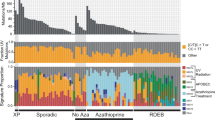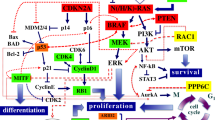Abstract
Cutaneous carcinosarcoma (CCS) is an extraordinarily rare neoplasm with a biphasic morphological pattern exhibiting both epithelial and sarcomatoid components. Although its histogenesis and biological aspects remain poorly understood, previous studies have postulated that this tumor may arise from single cancer stem cells which subsequently differentiate into distinct tumor lineages. In this study, we explored a wide array of mutational hot spot regions, through high-depth next-generation sequencing of 47 cancer-associated genes in order to assess the mutational landscape of these tumors and investigate whether the epithelial and mesenchymal components shared the same genetic signatures. Results from this study confirm that despite their striking phenotypic differences, both elements of this infrequent tumor indeed share a common clonal origin. Additionally, CCS appears to embrace a heterogeneous spectrum with specific underlying molecular signatures correlating with the defining epithelial morphotype, with those carcinosarcomas exhibiting a squamous cell carcinoma epithelial component exhibiting diverse point mutations and deletions in the TP53 gene, and those with a basal cell carcinoma morphotype revealing a more complex mutational landscape involving several genes. Also, the fact that our findings involve several targetable gene pathways suggests that the underlying molecular events driving the pathogenesis of CCS may represent future potential targets for personalized therapies.





Similar content being viewed by others
References
Dawson EK (1972) Carcinosarcoma of the skin. J R Coll Surg Edinb 17:243–246
Syme-Grant J, Syme-Grant NJ, Motta L, Howard Stevenson J, Evans AT (2006) Are primary cutaneous carcinosarcomas underdiagnosed? Five cases and a review of the literature. J Plast Reconstr Aesthet Surg 59:1402–1408
Brasanac D, Boricic I, Todorovic V (2008) Tomanovic N (2008) Primary cutaneous carcinosarcoma: case report with expanded immunohistochemical analysis. Int J Dermatol 47:496–501
Patel NK, McKee PH, Smith NP, Fletcher CD (1997) Primary metaplastic carcinoma (carcinosarcoma) of the skin: a clinicopathologic study of four cases and a review of the literature. Am J Dermatopathol 19:363–372
Tran TA, Muller S, Chaudahri PJ, Carlson JA (2005) Cutaneous carcinosarcoma: adnexal vs. epidermal types define high- and low-risk tumors. Results of a meta-analysis. J Cutan Pathol 32:2–11
Bigby SM, Charlton A, Miller MV, Zwi LJ, Oliver GF (2005) Biphasic sarcomatoid basal cell carcinoma (carcinosarcoma): four cases with immunohistochemistry and review of the literature. J Cutan Pathol 32:141–147
Rose RF, Merchant W, Stables GI, Lyon CL, Platt A (2008) Basal cell carcinoma with a sarcomatous component (carcinosarcoma): a series of 5 cases and a review of the literature. J Am Acad Dermatol 59:627–632
Upjohn E, Braue A, Ryan A (2010) Primary cutaneous carcinosarcoma: dermoscopic and immunohistochemical features. Australas J Dermatol 51:26–28
Smart CN, Pucci RA, Binder SW, Cassarino DS (2009) Cutaneous carcinosarcoma with myoepithelial differentiation: immunohistochemical and cytogenetic analysis of a case presenting in an unusual location. Am J Dermatopathol 31:715–717
Kantrow SM, Boyd AS (2007) Primary cutaneous metaplastic carcinoma: report of a case involving angiosarcoma. Am J Dermatopathol 29:270–273
Mc Menamin ME, Goh SG, Poblet E, Gostelow BE, Robson A, Calonje E (2006) Sarcomatoid basal cell carcinoma-predilection for osteosarcomatous differentiation: a series of 11 cases. Am J Surg Pathol 30:1299–1308
Luzar B, Perković T (2006) Cutaneous carcinosarcoma-basal cell carcinoma with osteosarcoma. J Cutan Pathol 33:591–592
Ram R, Saadat P, Peng D, Vadmal M (2005) Case report and literature review: primary cutaneous carcinosarcoma. Ann Clin Lab Sci 35:189–194
Chiyoda T, Tsuda H, Tanaka H, Kataoka F, Nomura H, Nishimura S, Takano M, Susumu N, Saya H, Aoki D (2012) Expression profiles of carcinosarcoma of the uterine corpus-are these similar to carcinoma or sarcoma? Genes, Chromosomes Cancer 51:229–239
Ambrosini-Spaltro A, Vaira V, Braidotti P, Rovati MPL, Ferrero S, Bosari S (2006) Carcinosarcoma of the colon: report of a case with morphological, ultrastructural and molecular analysis. BMC Cancer 6:185
Armstrong AB, Wang M, Eble JN, MacLennan GT, Montironi R, Tan PH, Lopez-Beltran A, Zhang S, Baldridge LA, Spartz H, Cheng L (2009) TP53 mutational analysis supports monoclonal origin of biphasic sarcomatoid urothelial carcinoma (carcinosarcoma) of the urinary bladder. Mod Pathol 22:113–118
Sung MT, Wang M, MacLennan GT, Eble JN, Tan PH, Lopez-Beltran A, Montironi R, Harris JJ, Kuhar M, Cheng L (2007) Histogenesis of sarcomatoid urothelial carcinoma of the urinary bladder: evidence for a common clonal origin with divergent differentiation. J Pathol 211:420–430
Singh RR, Patel KP, Routbort M et al (2013) Clinical validation of a next generation sequencing screen for mutational hotspots in 46 cancer-related genes. J Mol Diagn 15:607–622
Routbort M, Patel KP, Singh RR et al (2012) OncoSeek-A versatile annotation and reporting system for next generation sequencing-based clinical mutation analysis of cancer specimens. J Mol Diagn 14:747
Xu F, Zou WB, Li XP et al (2013) Multiple carcinosarcomas of the esophagus and stomach. Oncol Lett 5:1017–1021
Donnell CA, Pollock WJ, Sybers WA (1987) Thyroid carcinosarcoma. Arch Pathol Lab Med 12:1169–1172
Okudela K, Nakamura N, Sano J et al (2001) Thymic carcinosarcoma consisting of squamous cell carcinomatous and embryonal rhabdomyosarcomatous components. Report of a case and review of the literature. Pathol Res Pract 197:205–210
Arend R, Doneza JA, Wright JD (2011) Uterine carcinosarcoma. Curr Opin Oncol 5:531–536
Haraguchi S, Fukuda Y, Sugisaki Y et al (1999) Pulmonary carcinosarcoma: immunohistochemical and ultrastructural Studies. Pathol Int 10:903–908
Wick MR, Swanson PE (1993) Carcinosarcomas: current perspectives and a histological review of nosological concepts. Semin Diagn Pathol 10:118–127
El Harroudi T, Ech-Charif S, Amrani M et al (2010) Primary carcinosarcoma of the skin. J Hand Microsurg 2:79–81
Biernat W, Kordek R, Liberski PP et al (1996) Carcinosarcoma of the skin: case report and literature review. Am J Dermatopathol 18:614–619
Brown TJ, Tschen JA (1999) Primary carcinosarcoma of the skin: report of a case and review of the literature. Dermatol Surg 25:498–500
Hanly MG, Allsbrook WC, Pantazis CG et al (1994) Pilomatrical carcinosarcoma of the cheek with subsequent pulmonary metastases. A case report. Am J Dermatopathol 16:196–200
McKee PH, Fletcher CD, Stavrinos P et al (1990) Carcinosarcoma arising in eccrine spiradenoma. A clinicopathologic and immunohistochemical study of two cases. Am J Dermatopathol 12:335–343
McCluggage WG, Fon LJ, O'Rourke D et al (1997) Malignant eccrine spiradenoma with carcinomatous and sarcomatous elements. J Clin Pathol 50:871–873
Meriggi F, Tagliabò R, Morone G et al (1989) The potential malignancy of eccrine spiradenoma. Ital J Surg Sci 19:265–268
Mori O, Hachisuka H, Sasai Y (1990) Proliferating trichilemmal cyst with spindle cell carcinoma. Am J Dermatopathol 12:479–484
Plumb SJ, Stone MS (2002) Proliferating trichilemmal tumor with a malignant spindle cell component. J Cutan Pathol 29:506–509
Quay SC, Harrist TJ, Mihm MC Jr (1981) Carcinosarcoma of the skin. Case report and review. J Cutan Pathol 8:241–246
Schaefer IM, Enders C, Polten A et al (2011) Common genomic aberrations in basaloid squamous cell carcinoma and carcinosarcoma of the esophagus detected by CGH and array CGH. Am J Clin Pathol 135:579–586
Geyer FC, Weigelt B, Natrajan R et al (2009) Molecular analysis reveals a genetic basis for the phenotypic diversity of metaplastic breast carcinomas. J Pathol 220:562–573
Santiago Pérez JT, Pérez Vázquez MR, Rivera Valdespino A et al (2005) Carcinosarcoma of the breast: a tumour with controversial histogenesis. Clin Transl Oncol 7:255–257
Paniz Mondolfi AE, Jour G, Johnson M et al (2013) Primary cutaneous carcinosarcoma: insights into its clonal origin and mutational pattern expression analysis through next-generation sequencing. Hum Pathol 44:2853–2860
Nelson MA, Einspahr JG, Alberts DS et al (1994) Analysis of the p53 gene in human precancerous actinic keratosis lesions and squamous cell cancers. Cancer Lett 85:23–29
Brash DE (2006) Roles of the transcription factor p53 in keratinocyte carcinomas. Br J Dermatol 154:8–10
Xie J, Aszterbaum M, Zhang X et al (2001) A role of PDGFR alpha in basal cell carcinoma proliferation. Proc Natl Acad Sci U S A 98:9255–9259
Yang CM, Hsieh HL, Yao CC et al (2009) Protein kinase C-delta transactivates platelet-derived growth factor receptor-alpha in mechanical strain-induced collagenase 3 (matrix metalloproteinase-13) expression by osteoblast-like cells. J Biol Chem 284:26040–26050
Yang CM, Chien CS, Yao CC et al (2004) Mechanical strain induces collagenase-3 (MMP-13) expression in MC3T3-E1 osteoblastic cells. J Biol Chem 279:22158–22165
Andrae J, Gallini R, Betsholtz C (2008) Role of platelet-derived growth factors in physiology and medicine. Genes Dev 22:1276–1312
Donovan J, Abraham D, Norman J (2013) Platelet-derived growth factor signaling in mesenchymal cells. Front Biosci (Landmark Ed) 18:106–119
Athar M, Tang X, Lee JL et al (2006) Hedgehog signalling in skin development and cancer. Exp Dermatol 15:667–677
Daja-Grosjean L, Couvé-Privat S (2005) Sonic hedgehog signaling in basal cell carcinomas. Cancer Lett 225:181–192
Li C, Chi S, He N et al (2004) IFNalpha induces Fas expression and apoptosis in hedgehog pathway activated BCC cells through inhibiting Ras-Erk signaling. Oncogene 23:1608–1617
Kaur P, Mulvaney M, Carlson JA (2006) Basal cell carcinoma progression correlates with host immune response and stromal alterations: a histologic analysis. Am J Dermatopathol 28:293–307
Lin N, Moroi Y, Uchi H et al (2007) Significance of the expression of phosphorylated-STAT3, −AKT and -ERK-1/2 in several tumors of the epidermis. J Dermatol Sci 48:71–73
Hafner C, Landthaler M, Vogt T (2010) Activation of the PI3K/AKT signaling pathway in non-melanoma skin cancer is not mediated by oncogenic PIK3CA and AKT1 hotspot mutations. Exp Dermatol 19:e222–e227
Hafner C, Houben R, Baeurle A et al (2012) Activation of the PI3K/AKT pathway in Merkel cell carcinoma. PLoS One 7:e31255
Hafner C, López-Knowles E, Luis NM et al (2007) Oncogenic PIK3CA mutations occur in epidermal nevi and seborrheic keratoses with a characteristic mutation pattern. Proc Natl Acad Sci U S A 104:13450–13454
Groesser L, Herschberger E, Landthaler M et al (2012) FGFR3, PIK3CA and RAS mutations in benign lichenoid keratosis. Br J Dermatol 166:784–788
Miranda LQ, Fracaroli TS, Fonseca JC et al (2013) Analysis of mutations in the PIK3CA and FGFR3 genes in verrucous epidermal nevus. An Bras Dermatol 88:36–38
Matsuda S, Nakanishi A, Wada Y et al (2013) Roles of PI3K/AKT/PTEN pathway as a target for pharmaceutical therapy. Open Med Chem J 7:23–29
Almendro V, Marusyk A, Polyak K (2013) Cellular heterogeneity and molecular evolution in cancer. Annu Rev Pathol: Mech Dis 8:277–302
Gerlinger M, Rowan AJ, Horswell S et al (2012) Intratumor heterogeneity and branched evolution revealed by multiregion sequencing. N Eng J Med 366:883–892
Polyak K (2011) (2011) Heterogeneity in breast cancer. J Clin Invest 121:3786–3788
Bonavia R, Inda MM, Cavenee WK (2011) Heterogeneity maintenance in Glioblastoma: a social network. Cancer Res 71:4055–4060
Marusyk A, Polyak K (2010) Tumor heterogeneity: causes and consequences. Biochim Biophys Acta 1805:105
Guarino M, Rubino B, Ballabio G (2007) The role of epithelial-mesenchymal transition in cancer pathology. Pathology 39:305–318
Iwatsuki M, Mimori K, Yokobori T et al (2010) Epithelial-mesenchymal transition in cancer development and its clinical significance. Cancer Sci 101:293–299
Yanhia H, Xinchun J (2007) The role of epithelial-mesenchymal transition in oral squamous cell carcinoma and oral submucous fibrosis. Clin Chim Acta 383:51–56
Smith A, Teknos TN, Pan Q (2013) Epithelial to mesenchymal transition in head and neck squamous cell carcinoma. Oral Oncol 49:287–292
Jeanes A, Gottardi CJ, Yap AS (2008) Cadherins and cancer: how does cadherin dysfunction promote tumor progression? Oncogene 27:6920–6929
Hugo H, Ackland ML, Blick T et al (2007) Epithelial-mesenchymal and mesenchymal-epithelial transitions in carcinoma progression. J Cell Physiol 213:374–383
Conflict of interest
The authors declare no conflict of interest.
Author information
Authors and Affiliations
Corresponding author
Rights and permissions
About this article
Cite this article
Paniz-Mondolfi, A., Singh, R., Jour, G. et al. Cutaneous carcinosarcoma: further insights into its mutational landscape through massive parallel genome sequencing. Virchows Arch 465, 339–350 (2014). https://doi.org/10.1007/s00428-014-1628-0
Received:
Revised:
Accepted:
Published:
Issue Date:
DOI: https://doi.org/10.1007/s00428-014-1628-0




